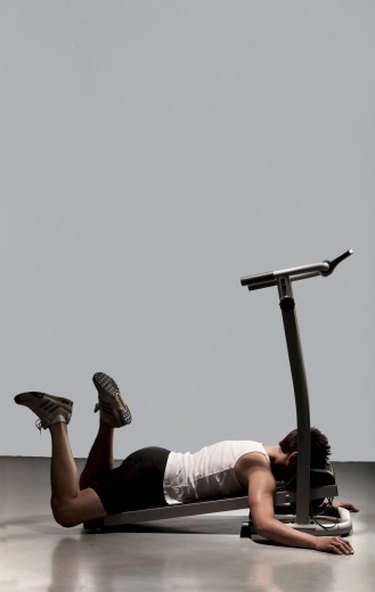
Determining the right treadmill size depends primarily on two things: your size and how you intend to use the machine. The belt and the motor are the most crucial components to correctly size, but other elements with proper sizing can increase your machine's efficiency.
Belt Size
Video of the Day
You can find belts from 13 to 22 inches wide and 40 to 60 inches long. Generally, machines with larger belts cost more. In addition, you will be giving up floor space to your treadmill, so right-sizing, instead of simply going with the biggest belt, makes the most sense. Anything less than 16 inches wide is difficult to walk on and precarious for running. An 18-inch belt is best for walking, but going up to 20 inches -- or wider -- is better for runners. Walkers can do quite well with a 48-inch long belt, but if you're planning to run faster than a jog, 54 inches will work better. If you're taller than 6 feet -- or if your inseam is at least 32 inches -- go even longer. But you won't need 60 inches unless you're at least 6-4. Remember: When choosing belt width, getting a machine wider than about 18 inches through the door could be a problem.
Video of the Day
Motor Size
The faster you move and the heavier you are, the more horsepower you need. Check the motor's continuous-duty horsepower -- and make sure the CHP is rated using 100 volts. You also need to check the motor's revolutions per minute rating. If you're a walker, you can get by with 1.5 CHP at less than 5,000 RPM. If you're going to run on the treadmill, you need at least 2.5 CHP at less than 4,000 RPM. And, if you weigh more than 180 pounds, you need more horsepower. Also, a motor that operates at more than 5,000 RPM will tend to overheat and wear out quickly.
Roller Size
Larger rollers are smoother and more efficient because they turn fewer revolutions at any given speed. Runners should look for at least 2.25-inch rollers, and 2.5-inch or bigger are even better. Walkers can get by with smaller rollers, but if you get 1.6-inch rollers, they will run hotter, which will make your treadmill prone to slight hesitations.
Deck Thickness
Medium density fiber-board -- not particle board -- is the best option for the deck. Walkers will do fine with a deck ¾-inch thick. Runners need at least 1-inch thickness to keep the board from being too bouncy and to lessen the chances of the deck cracking over time.
Frame Size
The frame ideally needs to be wide enough so that you don't have to stand on the belt as it starts moving. Some machines provide foot plants rather than widening the entire frame. You can get by with a narrow frame, but you'll have to mount the moving belt from the floor.
Overall Weight
Frames generally are made from steel or aluminum. Steel is heavier, which contributes to the overall weight of your machine. Generally, the heavier the machine, the less it will vibrate or bounce as you run.